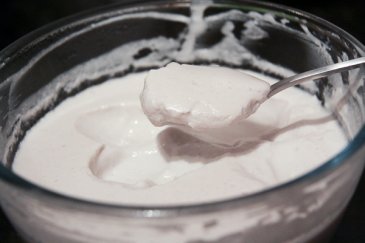Earlier this year, a PhD student in the US created yoghurt using the bacterial cultures from her own vagina and ate it. And it turns out it's actually not such a bad idea.
As Janet Jay reported for Motherboard back in February, her friend Cecilia Westbrook from the University of Wisconsin, Madison first decided to make her own vaginal yoghurt after realising that - despite the overwhelming amount of research on good and bad bacteria out there - no one had investigated the potential of the cultures living inside our vaginas.
In fact, science is so obsessed with the link between our gut bacteria and our health that the treatment du jour is the faecal transplant, where a doctor literally takes the sh*t out of someone else's colon and puts it in yours, in order to heal your gut from the inside out. Microbiologists are even smearing their newborn babies with vaginal fluids in order to imbue them with healthy bacteria.
But no one had researched what would happen if you consume the hundreds of types of bacteria that live inside our vaginas, or if culturing them was even possible. And so Westbrook took a wooden spoon, put it in her vagina and then dipped it in a bowl of milk and left it overnight to do its magic.
As Jay wrote for Motherboard: "Her first batch of yogurt tasted sour, tangy, and almost tingly on the tongue. She compared it to Indian yogurt, and ate it with some blueberries."
This, apparently, was not a good idea, because our vaginas contain a lot of bad, as well as good, bacteria. But overall, the experiment was pretty clever, as Rosanne Hertzberger, a Dutch microbiologist who studies vaginal bacteria at Washington University School of Medicine in the US, told ScienceAlert over email.
In fact, the dominant vaginal bacteria is Lactobacillus, which is the same genus that's used to make yoghurt and cheese. "Yogurt-Lactobacillus is not all that different from the vaginal Lactobacilli," explained Hertzberger. "They all produce heaps of lactic acid, both in the vagina and in yogurt."
But that doesn't necessarily mean her vagina bacteria would have been able to create yoghurt. After all, the yoghurt we buy at the supermarket is all made from a combination of subspecies of Streptococcus thermophilus and Lactobacillus bulgaricus.
So Hertzberger decided to replicate the experiment back in her own lab (with different Lactobacilli from healthy pregnant women, not her own). The results? After testing eight bacteria strains, only one was remotely successful at acidifying the milk it was placed in. She didn't taste it (we don't blame her), but: "In this case, the result was particularly chunky; sour milk, probably with loads of precipitated milk protein. It was no delicious tangy yogurt," she explained.
"The conclusion is that the yogurt from Westbrook probably contained a mixture of various kinds of bacteria. Some of which may have been her own vaginal inhabitants, but a number of them may have originated from the wooden spoon, or from the air, or from the kitchen counter, or from underneath her fingernails." Ew.
But Hertzberger argues that we need to see beyond the gross-ness of the experiment and think of the potential of the research - after all, once a bacterium has reproduced, not a single molecule of vagina (or wooden spoon, or fingernail bed) would remain in any resulting product.
And yoghurt cultured from our vaginal bacteria could have some benefits - for example, when we have a yeast infection or bacterial vaginosis. Or even to rub on our own babies one day if needed.
"Westbrook may have gone about her work somewhat clumsily, but her story fits very well in the important trend from anti- to probiotics. And as for the unappetising aspect? I guess we should just get over it," said Hertzberger.
Hear hear. After all, where would science be without researchers out there willing to eat their own vaginal yoghurt.
You can read Hertzberger's full thoughts on Westbrook's experiment (in Dutch) here, and more about Westbrook's original experiment over on Motherboard.
